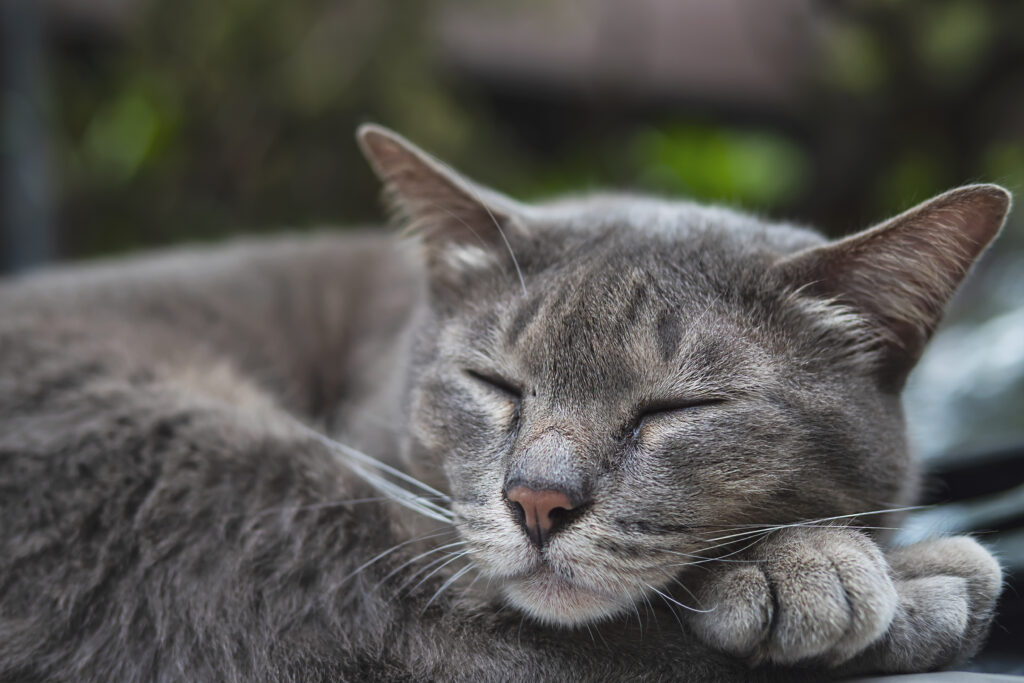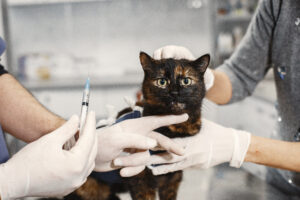Introduction
If you’re reading this, chances are you’re one of the millions of Americans who love cats but suffer from allergies. The sneezing, itchy eyes, and congestion can make cat ownership feel like an impossible dream. But what if there was a cat breed that could change that? Enter the Russian Blue cat – elegant, intelligent, and often touted as a solution for allergy sufferers.
The Russian Blue cat has gained tremendous popularity among allergy sufferers looking for a feline companion. With their striking silver-blue coat and emerald green eyes, these cats aren’t just beautiful – they’re also frequently described as hypoallergenic. But is the Russian Blue cat truly hypoallergenic? Are Russian Blue cats allergy-friendly as many claim? Or is the Russian Blue cat hypoallergenic myth just that – a myth?
In this comprehensive guide, we’ll explore everything you need to know about Russian Blue cat allergies, separate fact from fiction, and reveal four devastating myths that might be keeping you from finding the perfect feline companion. Whether you’re considering adding a Russian Blue to your family or looking for the best cats for allergy sufferers, this article will provide the science-backed information you need.
Russian Blue Cat Allergies

Understanding Cat Allergies: The Science Behind Your Symptoms
Before we dive into the specific case of the Russian Blue cat and allergies, it’s important to understand what causes cat allergies in the first place.
What Really Causes Cat Allergies?
Contrary to popular belief, cat allergies aren’t primarily triggered by fur or shedding. The main culprit is a protein called Fel d 1, which is found primarily in a cat’s:
- Saliva (Russian Blue cat saliva allergies are caused by this protein)
- Skin cells/dander (Russian Blue cat dander contains this allergen)
- Urine
- Sebaceous glands (oil-secreting glands in the skin)
- Russian Blue Cat Allergies
When cats groom themselves, they spread this protein onto their fur. As the saliva dries, microscopic particles become airborne and can be inhaled, causing allergy symptoms in sensitive individuals. Understanding this distinction is crucial – it’s not the fur itself causing allergies, but the proteins attached to it.
Common Cat Allergy Symptoms
Russian Blue cat allergy symptoms are no different from allergies to other cat breeds and typically include:
- Sneezing and runny nose
- Itchy, red, or watery eyes
- Coughing, wheezing, or difficulty breathing
- Skin rashes or hives where a cat has licked or scratched you
- Facial pain from nasal congestion
- Worsening of asthma symptoms
- Russian Blue Cat Allergies
For some people, symptoms are mild and manageable. For others, they can be severe enough to require medical attention. It’s important to note that allergic reactions can vary greatly between individuals, and someone might react differently to different individual cats, even within the same breed.
Myth #1: Russian Blue Cats Are Completely Hypoallergenic
The first and perhaps most devastating myth to debunk is that Russian Blue cats are completely hypoallergenic. The truth is more nuanced: no cat breed is truly 100% hypoallergenic.Russian Blue Cat Allergies
The Truth About “Hypoallergenic” Cats
When we talk about hypoallergenic cats, what we really mean is that certain breeds might produce fewer allergens or cause less severe reactions in some allergy sufferers. The term “hypoallergenic” indicates reduced allergens, not the complete absence of them.
Russian Blue Cat Allergies
Dr. James Seltzer, an allergist at the American College of Allergy, Asthma, and Immunology, notes: “There’s no such thing as a truly hypoallergenic cat. Some individual cats might produce less Fel d 1 than others, but this varies from cat to cat, not necessarily by breed.”
Are Russian Blue Cats Hypoallergenic? The Real Answer
While Russian Blue cats aren’t completely hypoallergenic, they do have certain characteristics that may make them more suitable for some allergy sufferers:
- Lower Fel d 1 Production: Some studies suggest that Russian Blues might produce less of the Fel d 1 protein than many other breeds, though individual cats can vary significantly.
- Dense Double Coat: The Russian Blue’s distinctive coat traps much of their dander and loose hair close to the skin rather than releasing it into the environment. This means less Russian Blue cat shedding and potentially fewer allergens in your home.
- Self-Grooming Habits: Russian Blues are fastidious groomers, which can mean less dander building up on their coat.
- Russian Blue Cat Allergies
However, if you’re severely allergic to cats, even a Russian Blue might trigger your symptoms. It’s always recommended to spend time with a specific cat before bringing them home if you have allergies.
As Dr. Carolyn Quagliata, veterinarian and feline specialist, explains: “While Russian Blues may be better tolerated by some allergy sufferers due to potentially lower allergen production, there’s still no guarantee that someone with cat allergies won’t react to a Russian Blue. It’s very individual.”

Myth #2: All Russian Blues Are Equally Low-Allergen
Another myth that can lead to disappointment is the belief that all Russian Blue cats have the same allergy-friendly properties. In reality, there can be significant variation between individual cats.
Individual Variation in Allergen Production
Research published in the Journal of Allergy and Clinical Immunology has shown that allergen production can vary significantly between individual cats, even within the same breed. Factors that can influence a Russian Blue cat’s allergen levels include:
- Sex: Male cats typically produce more Fel d 1 than females
- Age: Mature cats often produce more allergens than kittens
- Diet: Some studies suggest diet may influence allergen production
- Neutering status: Neutered males may produce fewer allergens than intact males
- Russian Blue Cat Allergies
The Impact of Russian Blue Cat Care on Allergen Levels
How you care for your Russian Blue can also affect how allergy-friendly they are:
- Regular Bathing: Washing your Russian Blue every 4-6 weeks can reduce allergen levels on their coat by up to 84%, according to a study published in the Journal of Allergy and Clinical Immunology.
- Grooming Routine: Brushing your Russian Blue cat’s fur regularly (ideally outdoors or by someone without allergies) can help remove loose fur and dander before it spreads in your home.
- Clean Living Environment: Frequent cleaning, HEPA air purifiers, and keeping the cat out of the bedroom can all help reduce exposure to allergens.
As feline behaviorist Jackson Galaxy notes: “Environmental management is just as important as choosing a potentially lower-allergen breed. How you live with the cat matters enormously.”
Russian Blue Cat Allergies
Myth #3: Russian Blues Are the Best Choice for All Allergy Sufferers
While Russian Blues are often included on any hypoallergenic cats list, they aren’t necessarily the best choice for everyone with allergies. Several factors should be considered when looking for allergy-friendly cats.
Comparing Russian Blue Cats to Other Low-Allergen Breeds
Russian Blue Cat Allergies
When considering the best cats for allergy sufferers, it’s worth looking at how Russian Blues compare to other breeds:
- Siberian: Despite their long coats, Siberians often have lower levels of Fel d 1, with some studies showing up to 75% less than average cats.
- Balinese: These elegant long-haired cats are known to produce less Fel d 1 than many short-haired breeds.
- Devon Rex and Cornish Rex: These breeds have very fine, short coats that shed minimally, which can mean fewer allergens in the environment.
- Sphynx: While not truly hairless, their minimal coat means less fur to trap allergens, though they still produce the allergenic proteins in their skin oils.
- Russian Blue Cat Allergies
When comparing Russian Blue vs Siamese allergies, both breeds are sometimes recommended for allergy sufferers, but neither is guaranteed to be better for every individual with allergies.
Finding Your Perfect Match: Beyond Breed Considerations
Dr. Elizabeth Colleran, past president of the American Association of Feline Practitioners, advises: “The best approach for potential cat owners with allergies is to spend significant time with the specific cat they’re considering adopting. Your reaction to an individual cat is more important than its breed.”
Before bringing home a Russian Blue cat, consider:
- Visiting a cattery or shelter with Russian Blues and spending at least an hour with them
- Asking to have a trial period with the cat in your home
- Starting with short exposure periods and gradually increasing time spent with the cat
- Consulting with an allergist who can help you develop a management plan
- Russian Blue Cat Allergies
Remember that the Russian Blue allergy level can vary from cat to cat, so finding the right individual matters more than focusing solely on the breed.
Myth #4: Managing Cat Allergies Is Impossible or Too Difficult
Perhaps the most devastating myth is that if you have allergies, you simply can’t live comfortably with a cat. In reality, many allergy sufferers successfully share their homes with feline companions through proper management strategies.
Effective Strategies for Managing Cat Allergies

Russian Blue Cat Allergies
If you’re determined to bring a Russian Blue or any cat into your home despite allergies, these strategies can help minimize symptoms:
- Create Allergen-Free Zones: Keep your bedroom completely cat-free to ensure you have a safe space with minimal allergens for sleeping.
- Air Purification: HEPA air purifiers can remove airborne cat allergens. Place them in rooms where you and your cat spend the most time.
- Regular Cleaning: Use a HEPA vacuum cleaner daily and clean surfaces with damp cloths to capture dander rather than dispersing it.
- Washing Hands: Always wash hands after petting your cat and avoid touching your face until you do.
- Medication Options: Consult with an allergist about antihistamines, nasal sprays, or other treatments that might help manage symptoms.
- Allergy Immunotherapy: For severe allergies, consider discussing allergy shots with your doctor, which can reduce sensitivity over time.
- Special Cat Products: Consider products designed to reduce allergens, such as Purina Pro Plan LiveClear, a cat food that has been shown to reduce allergens in cat hair and dander.
- Russian Blue Cat Allergies
Success Stories: Living with Russian Blue Cats Despite Allergies
Many allergy sufferers have found that with proper management, they can successfully live with Russian Blues. Sarah Thompson, a Russian Blue owner with moderate cat allergies, shares: “I’ve always loved cats but struggled with allergies. My Russian Blue, Luna, definitely causes fewer symptoms than other cats I’ve been around, but I still need to be careful. I take an antihistamine daily, keep her out of my bedroom, and have HEPA filters throughout the house. The extra effort is completely worth it for the joy she brings to my life.”
Russian Blue Cat Allergies
Dr. Lisa Pierson, a veterinary consultant, adds: “I see many successful human-feline relationships in homes with allergy sufferers. It takes commitment and consistent management, but many of my clients with allergies have found that the companionship of their Russian Blue or other cat is well worth the adaptation to their lifestyle.”
Living with a Russian Blue: Practical Advice for Allergy Sufferers
If you’re convinced that a Russian Blue might be right for you despite potential allergies, here are some specific tips for minimizing Russian Blue cat fur and allergies in your home:
Grooming Your Russian Blue to Minimize Allergens
Russian Blue Cat Allergies
The dense double coat of the Russian Blue cat requires regular attention to minimize shedding and allergen distribution:
- Brush regularly: Despite their relatively low shedding compared to other breeds, Russian Blues still benefit from weekly brushing to remove loose fur and dander. Use a rubber brush or fine-toothed comb.
- Consider professional grooming: Some groomers offer special treatments designed to reduce dander and allergens.
- Bathing options: While most cats don’t need frequent baths, using products specifically designed to reduce dander can be helpful for allergy sufferers. Consult your veterinarian for recommendations suitable for your Russian Blue’s coat type.
- Russian Blue Cat Allergies
Creating an Allergy-Friendly Home Environment
Beyond managing your Russian Blue cat’s fur and allergies directly, consider these environmental modifications:
- Flooring choices: Hard flooring like wood, tile, or vinyl is much easier to keep free of pet dander than carpet.
- Furniture considerations: Leather or vinyl furniture doesn’t trap allergens the way fabric upholstery does.
- Washing cat bedding: Clean your cat’s favorite sleeping spots weekly in hot water to reduce allergen buildup.
- Air filtration placement: Place HEPA air filters in the rooms where your Russian Blue spends the most time.
- Routine cleaning schedule: Establish a regular cleaning routine that includes wiping down surfaces, washing curtains, and cleaning behind furniture where dander can accumulate.
- Russian Blue Cat Allergies
Making an Informed Decision: Is a Russian Blue Right for You?
Before bringing a Russian Blue cat home, it’s important to make an informed decision based on your specific situation and allergy severity.
Questions to Ask Yourself Before Adopting
Russian Blue Cat Allergies
- How severe are my allergies? Be honest about your sensitivity level. Mild allergies are more likely to be manageable than severe ones.
- Am I willing to commit to the necessary cleaning and management routines? Living with a cat when you have allergies requires consistent effort.
- Have I spent enough time with Russian Blues to know how I react? Individual exposure
- Do I have support from healthcare providers? Consult with an allergist for personalized advice and treatment options.
What’s my contingency plan? Consider what you’ll do if your allergies prove too severe despite management efforts.
Resources for Potential Russian Blue Owners with Allergies
If you’re considering a Russian Blue cat despite allergies, these resources can help:
The International Cat Association (TICA) – Information on Russian Blue breed standards and reputable breeders
The American College of Allergy, Asthma and Immunology – Professional guidance on managing pet allergies
PetsPump.com’s Complete Guide to Cat Breeds – Comprehensive information on various cat breeds including allergy considerations
PetsPump.com’s Cat Health Center – Resources for maintaining optimal health for your Russian Blue
PetsPump.com’s Guide to Cat Grooming – Specific grooming advice that can help reduce allergens
Conclusion: The Reality of Russian Blue Cat Allergies
The relationship between Russian Blue cats and allergies is complex. While Russian Blues may indeed be more allergy-friendly than some other breeds, describing them as “hypoallergenic” is misleading. The Russian Blue cat hypoallergenic myth persists because many people with mild to moderate allergies do find they can tolerate these beautiful blue cats better than others.
If you’re considering a Russian Blue cat and have allergies, approach the situation with realistic expectations:
Russian Blues may produce fewer allergens than some other breeds, but they still produce the proteins that cause allergic reactions.
Individual cats within the breed vary significantly in their allergen production.
Proper management techniques are essential for successfully living with a cat if you have allergies.
Spending time with a specific Russian Blue before committing to adoption is the only way to truly know if you can tolerate that individual cat.
As Dr. Karen Becker, a prominent veterinarian, notes: “The myth that certain cats are completely hypoallergenic can lead to heartbreaking situations where adopted cats must be rehomed when allergies prove too severe. It’s better to understand the reality and make an informed decision based on your individual circumstances.”
Whether a Russian Blue is ultimately right for you depends on many factors, including your allergy severity, commitment to management strategies, and the specific cat’s allergen levels. With proper research, preparation, and management, many allergy sufferers find that the companionship of a Russian Blue cat is well worth the extra effort required to minimize allergic reactions.
Remember that while Russian Blue cats might be among the best cats for allergy sufferers, no cat can guarantee an allergy-free experience. The bond between you and your feline companion, however, might just make any necessary accommodations worthwhile.
Disclaimer: This article is for informational purposes only and is not intended to replace professional medical advice. If you suffer from cat allergies, consult with an allergist or immunologist before bringing a cat into your home.






